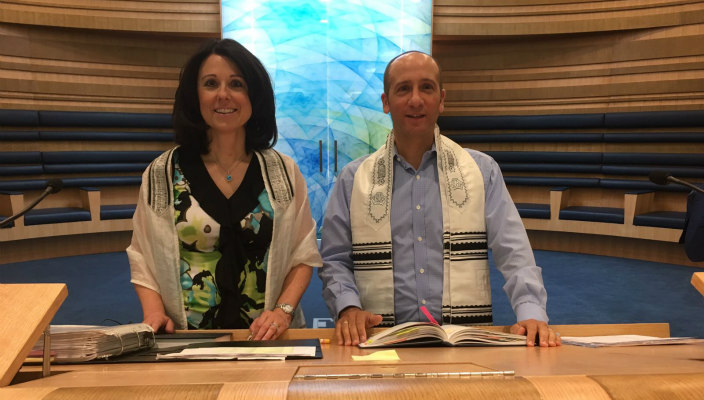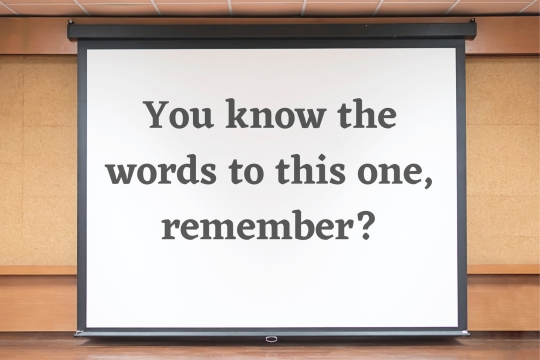
Cantorial Soloist Tara Abrams: Our synagogue, Temple Har Zion (THZ), is a medium-sized congregation in the greater Toronto area in Ontario, Canada, led by Rabbi Cory Weiss and me; I function as a full-time cantor. When Rabbi Weiss went on sabbatical for eight months, the THZ leadership relied on me to be its constant clergy, not only working with and assisting a temporary rabbi, but also fulfilling additional responsibilities on my own when the rabbi was not on duty at the synagogue.
We hired an Israeli rabbi, Rabbi Benjie Gruber, to fill the role of half-time sabbatical rabbi, working closely with me, and together leading the congregation for the duration of the sabbatical. The other half of his job was as scholar-in-residence for ARZA Canada, bringing the message of the Reform Movement in Israel to URJ-affiliated congregations in Canada. By partnering with ARZA Canada, THZ benefitted from the continuity and consistency of having one rabbi, and ARZA Canada benefitted from having an Israeli rabbi bringing the message of that organization to many of the Reform congregations in Canada. Both jobs together created a full-time position, thus making it feasible for Benjie to bring his family to Canada, and become part of the THZ community.
Rabbi Benjie Gruber: As my role in Israel did not provide me with the experience required to be a North American pulpit rabbi, before the job began, I requested that Tara and I do some work beforehand to be as prepared as possible, especially for my role on the bimah (pulpit).
We focused on the several types of services and the minhagim (customs) at THZ. It was very helpful for me to hear the temple’s vast musical repertoire and to learn about the key role that music plays in the worship experience there. Once I arrived in Toronto, Tara and I worked together to create the correct balance between Hebrew, English, and music in services.
I discovered that Shabbat services at THZ were more formal than in the Arava (Israeli geographic region south of the Dead Sea), with clergy facing the congregation, instead of the circular-style seating at Kibbutz Yahel. Praying in English also was a new experience.
Abrams: Funerals in North America are more formal than they are at kibbutzim, and his experience in Israel did not fully prepare Rabbi Gruber for officiating at funerals in Toronto. Along with information from Rabbi Weiss, I helped guide him through the process.
Leading Torah Study approximately twice a month, Rabbi Gruber taught in English, often using both Hebrew and English sources. Because every translation is a commentary, at times it provided challenges for both him and the attendees. He focused his Torah study sessions on "Israeli" Torah – poems and literature written by Israelis, all well received.
With my assistance, Rabbi Gruber officiated at a wedding, finding it both interesting and frustrating that although he is an Israeli rabbi who was ordained in Israel, his signature was legally valid on a wedding certificate in the Province of Ontario, unlike in Israel, where Reform weddings are not recognized by the State.
To fulfill his role for the purposes of bikkur cholim (visiting the sick), I often made visits with Rabbi Gruber, making introductions and together counseling those in need.
Gruber: As scholar-in-residence for ARZA Canada, I visited most of the Reform congregations in Canada. Divrei Torah (words of Torah), text study, and sharing information and participating in discussions allowed me to relate to the participants what it means to be both a Reform Jew and rabbi in Israel today. As much as I taught, I also learned about Canadian Reform Jewry.
Although I found the observance of Yom HaShoah, Yom HaZikaron, and Yom Ha’Atzmaut at THZ to be meaningful, the experience was very different for me, and at times difficult; just having the office open on those days felt strange. Despite participating in a moving Yom HaShoah service that Tara created with Holocaust survivors, their families, and young people in the congregation, I missed hearing the siren and 24-hour observance in Israel.
As the eight months progressed, it became clear to me that one main difference between living and celebrating one’s Judaism in Israel versus Canada is that in Israel, it is in the public sphere. Canadian Jews very much rely on their connection to and investment in Jewish institutions to feel part of a Jewish community.
In Israel, Judaism happens and is celebrated culturally on the street. No additional investment is needed. When one buys a falafel during Passover, it is wrapped in a wet piece of matzah. Outside Israel, for Judaism to be felt even mildly, Jews need to make it happen.
Abrams: Having an Israeli rabbi serve a Canadian congregation allowed Reform Jews in Canada to gain a closer perspective of life in Israel, Reform Judaism in Israel, and Israeli life in general.
Our THZ leadership and members were extremely happy with Rabbi Gruber as our sabbatical rabbi. He took home an understanding of what it means to serve a Reform congregation in North America, and about Reform Judaism in the Diaspora. He shared Israeli melodies with THZ and also took home new melodies to the Arava.
The future of Reform Judaism depends on serious connections between liberal Jews in Israel and the Diaspora, and the partnership between the two of us worked very well, respecting one another’s needs and challenges, and creating a successful model for others.
Tara Abrams has been the cantorial soloist at Temple Har Zion in Toronto, Ontario, for 16 years, where she fills the role of a full-time cantor. Rabbi Benjie Gruber serves as the spiritual leader at Kibbutz Yahel in the Arava region of Israel.
Have something to say about this post? Join the conversation in The Tent, the social network for congregational leaders of the Reform Movement. You can also tweet us or tell us how you feel on Facebook.
Related Posts

Digital Content to Enliven Your Passover Seder

Bring Your Words to Life: Making Online Worship Accessible
